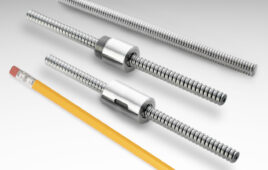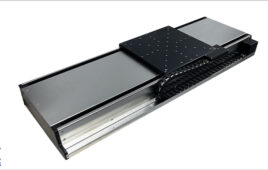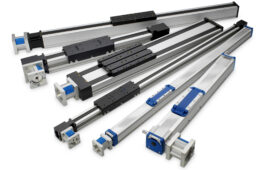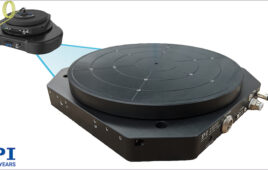Seals for recirculating linear bearings serve two functions — keeping contamination out and keeping lubrication in — to ensure the system operates properly without premature wear or failure. Because sealing is so critical to linear bearing systems, manufacturers offer a variety of sealing designs and materials to meet a wide range of applications and environments.
Standard linear bearing seals
The basic seal offered by most recirculating linear guide manufacturers is either a single- or double-lipped style. These seals make positive, line contact with the rail, for good protection against both fine particulates and liquids.
Double-lipped seals provide two barriers between the external environment and the internal components of the bearing, and are often used for very fine dust — such as ceramic or glass — and hazardous chemicals. Some manufacturers also offer triple-lipped seals as an optional accessory.

Image credit: Bosch Rexroth
When contamination includes large, coarse debris that could damage the lip seals — such as metal or wood chips or welding slag — a metal scraper can be used in addition to the standard lip seals. Metal scrapers leave a small gap between the seal and the guide rail, but they do a good job of wiping, or scraping, larger debris from the rail. It’s important to note that because they’re non-contacting, metal scrapers aren’t typically suitable for use on their own, without additional sealing options.

Image credit: Hiwin
Most recirculating linear bearing designs also include internal (sometimes referred to as universal) seals, which protect against any contamination that makes its way past the front seal or that may collect in or around the rail mounting holes.

Image credit: SKF
When we think of linear bearing seals, we typically think of the front seals, located on each end of the bearing block. But most recirculating linear bearings also include side seals (also referred to as longitudinal or lateral seals) as a standard component. These prevent contamination from entering from below, along the sides of the bearing block — particularly when the assembly is mounted on its side, vertically or upside-down. However, while side seals provide an additional layer of protection, the front seals typically do the bulk of the work in terms of keeping contaminants out.

Image credit: THK
Seals for special applications and environments
Standard seals for recirculating bearings are made of thermoplastic material (TEEE) such as Hytrel from Dupont. And most manufacturers offer versions made of fluoroelastomer (FPM or FKM) such as Viton from Chemours, which are compatible with a wide range of chemicals and lubricants. Fluoroelastomers also have a large range of operating temperatures, so can be used in both high- and low-temperature environments.
In some environments — particularly in cleanrooms — the particulate released to the environment due to seal drag is a greater concern than contamination from the operating environment entering the bearing block. For these cases, manufacturers offer low-friction versions of bearing seals. These are typically contacting-type seals, but with less preload between the seal and the rail surfaces than a standard contacting-type seal. Low-friction seals are also used in applications where seal drag (friction due to the bearing seals) should be minimized to meet application requirements, such as low running torque or force.
Keep in mind that the more contact the seal makes with the running surface, the more force is required to overcome the seal friction. This additional friction can affect the sizing and selection of the system’s drive components. Manufacturers often publish (or can provide) the amount of force required to overcome friction due to seals.

Image credit: Bosch Rexroth
Although seals are recommended for profiled rail linear guides, due to their importance in maintaining proper lubrication, round shaft linear guides and cam roller guides can be operated without seals. Plain bearing linear guides are also typically used without seals, unless the environment contains significant contamination.
Filed Under: Linear Motion Tips




